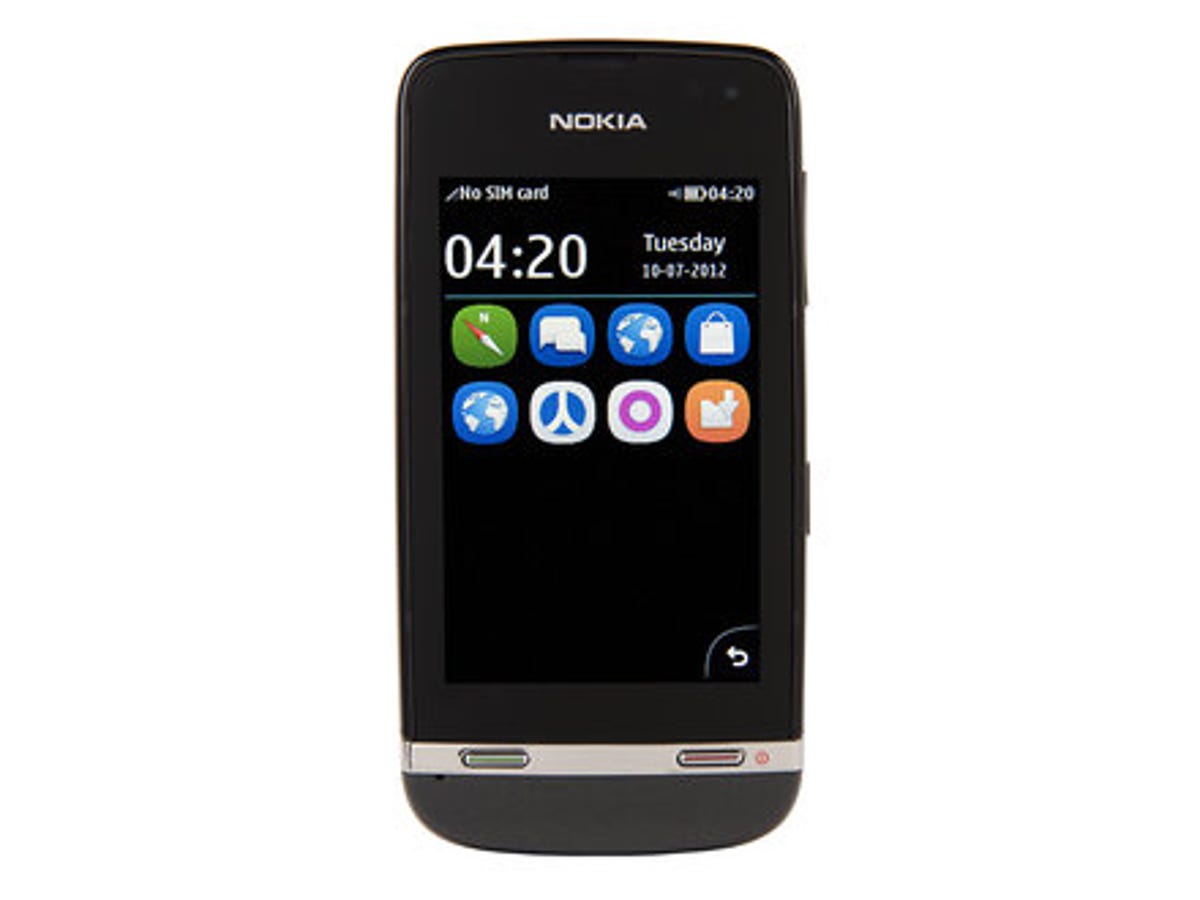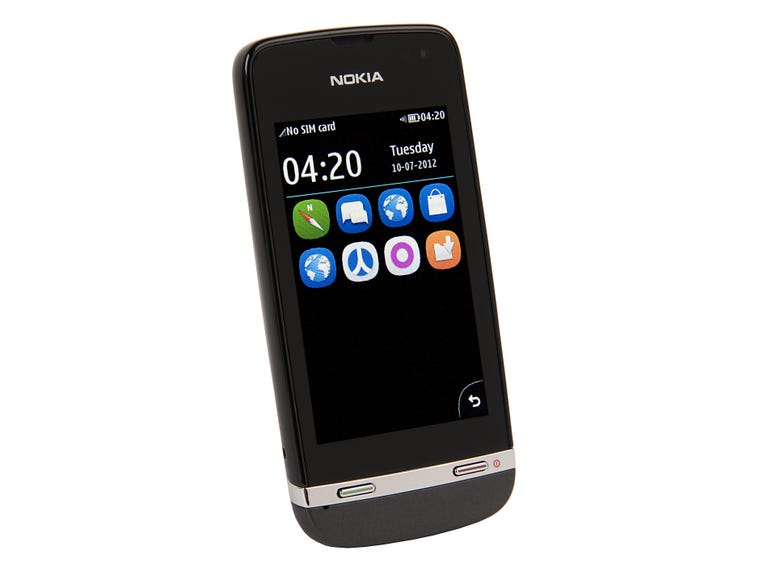 Why You Can Trust CNET
Why You Can Trust CNET Nokia Asha 311 review: Nokia Asha 311
The Nokia Asha 311 runs old technology masked by a lick of paint to try and pass it off as a serious competitor to slicker phone OSes.
Considering how much noise Nokia makes about its Microsoft partnership these days, you'd be forgiven for thinking all its phones ran Windows Phone. Au contraire. Nokia is still making a Series 40-based line of cheaper, basic smart phones primarily aimed at budget-conscious mobile users -- its Asha range of handsets.
The Good
The Bad
The Bottom Line
Early Ashas were Qwerty or keypad-clad creations but the once Mighty Finn has now unboxed some fully touchscreen options, including the Asha 311, which is available SIM-free for around £100.
Nokia is hoping these swipe-friendly Ashas will be snatched off shelves by Brits seeking a cheap alternative to a budget Android. But is that wishful thinking?
Should I buy the Nokia Asha 311?
The Asha 311 is certainly cheap but it's not affordable enough to put clear blue water between itself and the gaggle of budget Androids clamouring for your cash.

To compete with the might of Android, the Asha 311 really needs to be £50 or £60 cheaper to even start to be worth considering. Instead, it's currently about the same price. It's now possible to pocket an excellent 'droid for £100 -- giving access to scores of apps on Google's Play store, a 1GHz chip and a roomy 4-inch screen.
So you get far better value for your hard-earned cash buying into Android, and a slicker, more capable smart phone in your pocket, so there's really no reason to choose the Asha over a decent budget 'droid.
The Asha 311 is an improvement on Series 40 devices from years gone by -- having had a spit and polish in the usability stakes and key apps pre-loaded -- but it's still far more gnomic, frustrating and flaky than plenty of 'droids in its price range.
The 311 might appeal to dedicated Nokia fans who are already well versed in the ways of Series 40. But everyone else is better off adopting a capable budget Android such as the Huawei Ascend G300, the T-Mobile Vivacity or -- for a smidge more cash -- Sony's Xperia U.
Design and build quality
Nokia hasn't pushed the boat out for the Asha 311's design -- beyond offering a standard candybar blower in some bright shades (including popping pink and brilliant blue). It's no stunner but it's not hideous either.
The front of the phone is all touchscreen apart from a plastic cap at the base, topped off with a silver bar that wraps all the way around the back of the phone. On the front, this bar houses Nokia's trademark call buttons (one of which is also the power/cancel key). On the right-hand edge you also get a volume rocker and a physical lock key -- which I found a little stiff to press.
Siting the power key on the front isn't amazingly intelligent design -- if you're cramming the phone into a packed bag, I found it could turn itself on if switched off.
Overall, the phone has a very plasticky feel and -- thanks to its high-shine curved backplate -- a habit of tumbling out of your hands at inopportune moments.
Build quality feels pretty rigid, but applying pressure will generate a few plasticky squeaks. I also found that because the back is so shiny, it's annoyingly hard to remove to get at the battery, SIM and microSD card slots. It's a case of applying both thumbs and keep pushing.
There are three external ports all sited on the top edge: Nokia's proprietary power port, a micro-USB socket for transferring media to and from a computer and a 3.5mm headphone jack.
Screen
The 311 stands out from fellow Ashas such as the 201, because it lacks a physical keyboard or keypad. Instead, you get a 3-inch full touchscreen display, toughened with Gorilla Glass.
Its resolution is only 240x400 pixels, which equates to a lowly density of 155 pixels per inch. At this resolution, when fully zoomed out of a desktop web page such as the CNET UK site, text is completely illegible and you have to tap to zoom in to read every block of text.
Overall, the display lacks crispness and has a hazy appearance -- so photos and websites look murky and poorly defined. Colours also look more muted than vibrant.
The touchscreen's responsiveness isn't bad, but it feels sluggish when responding to your taps. A slight feeling of inertia accompanies everything you do. This lag is more likely to be the fault of the Series 40 software than cheap screen hardware.
Series 40 and apps
Series 40 is one of Nokia's legacy operating systems from mobile days gone by. In these smart phone-dominated times, it lags far behind the Speedy Gonzales duo of Apple's iOS and Android.
On the Asha 311, Series 40 isn't as old skool as it used to be, displaying various borrowed elements from iOS and Android -- such as a grid of round-edged icons and a tray that can be swiped down from the top of the home screen to get to certain settings.
When you flick to scroll through the icons, they come to rest with a bump and bounce after the last row is reached (much like the iPhone's icons).
So, on the surface, Series 40 looks like familiar smart phone territory -- with friendly looking icons and swipeable home screens. But legacy baggage soon shows its face in the form of inscrutable error messages and parades of confirmation pop-ups, much like the dialogue boxes that haunt Windows PCs.
This sort of user interface is how things used to be in the bad old days of mobile devices. Happily, UI design has swiped on elsewhere, so there's no need to tether yourself to such a neurotic system unless you're a diehard Nokia fan.
One neat touch for people who do a lot of calling is that the dialler entirely occupies one of the home screens, meaning you can get to it quickly just by swiping left from the main screen.
If you're wondering about apps, they are available via Nokia's Ovi store. Some also come pre-loaded, including perennial favourite Angry Birds (the game's maker Rovio is, after all, a Finnish company). There's Twitter and Nokia's Social app, which lets you gather social network updates from Facebook et al into one highly social hub. Nokia Maps also comes pre-loaded.
While the range of apps on Ovi is less extensive than iOS or Android, Nokia has done a deal with games maker EA so you can download 40 of its titles for free -- provided you do so within 60 days of opening up the Games Gift icon.
Performance
Series 40 isn't the slickest or easiest OS to use, nor is it the most error-free. I encountered quite a lot of errors -- especially during the set-up of functions such as email -- which temporarily derailed elements including web browsing and social apps.
Some of the apps are also flaky and/or buggy. Nokia's Social app, for instance, indicates you have new Facebook messages when there's nothing new in your inbox.
At other times during testing, the app flaked out entirely -- throwing up this less-than-useful message:
The web browser -- when it works -- manages to be quick but it's also distinctly low-fi. It loads pages speedily because it serves up a compressed version of the sites, which means graphics look blurry and poor, but are typically quick to appear. There's a second advantage in that they don't gobble up so much of your data download allowance -- so if you're really concerned about 3G data costs, this could be handy.
The other annoying element of the web browser is that as the resolution is so poor (and the screen so small), you have to tap to zoom in to read text. And, as there's only one level of zoom, reading an entire web page means loads of swiping around as you finish consuming each small block of text in your immediate field of vision. The result can feel like trying to read a dictionary by looking through a keyhole.
The virtual keyboard on the 311 is a keypad-style offering, rather than a full Qwerty, so there's no denying you're the owner of a candybar blower.
Like the OS, apps are generally a little sluggish to run, so it's hard to shake the feeling that everything you do on the 311 is ever so slightly behind what your fingertips are asking. If you're an impatient type, this foot-dragging will soon grate, but if you're zen about marginal delays, you may not care.
The 311 has both front and rear speakers and can pump out noise pretty loudly -- which could come in handy on the school bus. Call quality was ok but voices sounded a tad muffled to my ear.
Hardware
What hardware do you get for your cash? A 1GHz chip, 128MB of memory and both a 3G and Wi-Fi radio plus Bluetooth -- a full connectivity complement that you don't get on every Asha.
There's also a GPS chip so you can make full use of the pre-loaded Nokia maps app.
Also on board is a 1,110mAh battery, which Nokia reckons is good for up to 6 hours of 3G talktime, 40 hours of music playback or 744 hours on standby. It should easily last you a day's poking and prodding, provided you're not an ultra-heavy user.
The 311 has a 3.2-megapixel camera on the back. You certainly shouldn't expect anything great from this lens. Test snaps I took came out really blurry and speckled, with chromatic aberration (colour fringing around sharply contrasting objects), grainy noise, haloing and lens flare.
There's no flash so you can't add additional luminosity when snapping in dingier conditions either.
The 311 records video at a resolution of 480x640 pixels. Again, results aren't amazing but it'll serve for making YouTube-quality clips.
Conclusion
The Nokia Asha 311 may be the most easy to use Series 40 device Nokia has ever made, but that's damning it with the faintest of praise. It's saddled with legacy baggage that throws up cryptic error messages and annoying confirmation requests far too often to make it a pleasure to use. This is old technology given a new lick of paint to try and pass it off as a serious competitor to slicker rival operating systems.
Unless you're a dyed-in-the-wool Nokia fan, you're far better off spending your budget on a decent 'droid. Indeed, it's possible to get a powerful, capable Android handset -- such as Huawei's excellent Ascend G300 -- for the same as the Asha 311. So unless there's a radical price drop or some really compelling contracts coming down the line, there's no reason to bother with Nokia's candybar.


